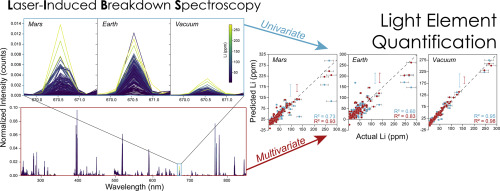当前位置:
X-MOL 学术
›
Spectrochim. Acta B. At. Spectrosc.
›
论文详情
Our official English website, www.x-mol.net, welcomes your
feedback! (Note: you will need to create a separate account there.)
Accuracies of lithium, boron, carbon, and sulfur quantification in geological samples with LIBS in Mars, Earth, and vacuum conditions
Spectrochimica Acta Part B: Atomic Spectroscopy ( IF 3.2 ) Pub Date : 2019-12-01 , DOI: 10.1016/j.sab.2019.105715 Cai R. Ytsma , M. Darby Dyar
Spectrochimica Acta Part B: Atomic Spectroscopy ( IF 3.2 ) Pub Date : 2019-12-01 , DOI: 10.1016/j.sab.2019.105715 Cai R. Ytsma , M. Darby Dyar

|
Abstract Laser-induced breakdown spectroscopy (LIBS) is valued for its ability to remotely detect a wide range of elements, including light elements, under a variety of atmospheric conditions. This study uses LIBS spectra of 402 rock standards to quantify lithium (Li), boron (B), carbon/carbon dioxide (C/CO2), and sulfur (S) in Mars and Earth atmospheres and under vacuum. Two regression methods were tested: univariate analysis (UVA), here using peak areas to predict concentrations, and multivariate analysis (MVA). Partial least squares (PLS) and the least absolute shrinkage and selection operator (lasso) use information from larger regions of LIBS spectra. Rock powders were doped with up to 10 wt% of each light element to help identify strongly correlated peaks for UVA. UVA and MVA models were assessed using root mean square errors (RMSEs) of cross-validation (CV), calibration RMSEs, and R2 correlation between predicted and true concentrations. Li had the most strongly correlated peaks, similar UVA and MVA model performance, and the lowest relative prediction errors. B and C had few weakly-correlated peaks, leading to extremely poor UVA R2 correlations despite having similar RMSEs to MVA models with mediocre performance. S had no visible peaks in our LIBS setup and as a result, MVA models had extremely high prediction errors. Model performance was not significantly affected by atmospheric differences despite visible changes in peak appearance, as long as model and test data were acquired under identical conditions. PLS regression on the entire LIBS spectrum consistently created models with the lowest quantification errors and highest R2 correlations. Light element predictions may be improved using higher resolution, gated spectrometers that cover a wider wavelength range than those used in our setup, which matches ChemCam.
中文翻译:

在火星、地球和真空条件下使用 LIBS 对地质样品中的锂、硼、碳和硫进行定量的准确性
摘要 激光诱导击穿光谱 (LIBS) 因其能够在各种大气条件下远程检测包括轻元素在内的多种元素而受到重视。本研究使用 402 种岩石标准的 LIBS 光谱来量化火星和地球大气层以及真空下的锂 (Li)、硼 (B)、碳/二氧化碳 (C/CO2) 和硫 (S)。测试了两种回归方法:单变量分析 (UVA),这里使用峰面积来预测浓度,以及多变量分析 (MVA)。偏最小二乘法 (PLS) 和最小绝对收缩和选择算子 (lasso) 使用来自 LIBS 光谱较大区域的信息。岩粉中掺杂了高达 10 wt% 的每种轻元素,以帮助识别 UVA 的强相关峰。UVA 和 MVA 模型使用交叉验证 (CV) 的均方根误差 (RMSE)、校准 RMSE 和预测浓度与真实浓度之间的 R2 相关性进行评估。Li 具有最强烈的相关峰、相似的 UVA 和 MVA 模型性能以及最低的相对预测误差。B 和 C 几乎没有弱相关峰,导致 UVA R2 相关性极差,尽管与 MVA 模型具有相似的 RMSE,但性能一般。S 在我们的 LIBS 设置中没有可见的峰值,因此,MVA 模型具有极高的预测误差。只要模型和测试数据是在相同条件下获得的,尽管峰值出现明显变化,但大气差异不会显着影响模型性能。整个 LIBS 光谱上的 PLS 回归始终创建具有最低量化误差和最高 R2 相关性的模型。使用更高分辨率的门控光谱仪可以改进轻元素预测,该光谱仪覆盖的波长范围比我们设置中使用的光谱仪更宽,与 ChemCam 相匹配。
更新日期:2019-12-01
中文翻译:

在火星、地球和真空条件下使用 LIBS 对地质样品中的锂、硼、碳和硫进行定量的准确性
摘要 激光诱导击穿光谱 (LIBS) 因其能够在各种大气条件下远程检测包括轻元素在内的多种元素而受到重视。本研究使用 402 种岩石标准的 LIBS 光谱来量化火星和地球大气层以及真空下的锂 (Li)、硼 (B)、碳/二氧化碳 (C/CO2) 和硫 (S)。测试了两种回归方法:单变量分析 (UVA),这里使用峰面积来预测浓度,以及多变量分析 (MVA)。偏最小二乘法 (PLS) 和最小绝对收缩和选择算子 (lasso) 使用来自 LIBS 光谱较大区域的信息。岩粉中掺杂了高达 10 wt% 的每种轻元素,以帮助识别 UVA 的强相关峰。UVA 和 MVA 模型使用交叉验证 (CV) 的均方根误差 (RMSE)、校准 RMSE 和预测浓度与真实浓度之间的 R2 相关性进行评估。Li 具有最强烈的相关峰、相似的 UVA 和 MVA 模型性能以及最低的相对预测误差。B 和 C 几乎没有弱相关峰,导致 UVA R2 相关性极差,尽管与 MVA 模型具有相似的 RMSE,但性能一般。S 在我们的 LIBS 设置中没有可见的峰值,因此,MVA 模型具有极高的预测误差。只要模型和测试数据是在相同条件下获得的,尽管峰值出现明显变化,但大气差异不会显着影响模型性能。整个 LIBS 光谱上的 PLS 回归始终创建具有最低量化误差和最高 R2 相关性的模型。使用更高分辨率的门控光谱仪可以改进轻元素预测,该光谱仪覆盖的波长范围比我们设置中使用的光谱仪更宽,与 ChemCam 相匹配。









































 京公网安备 11010802027423号
京公网安备 11010802027423号